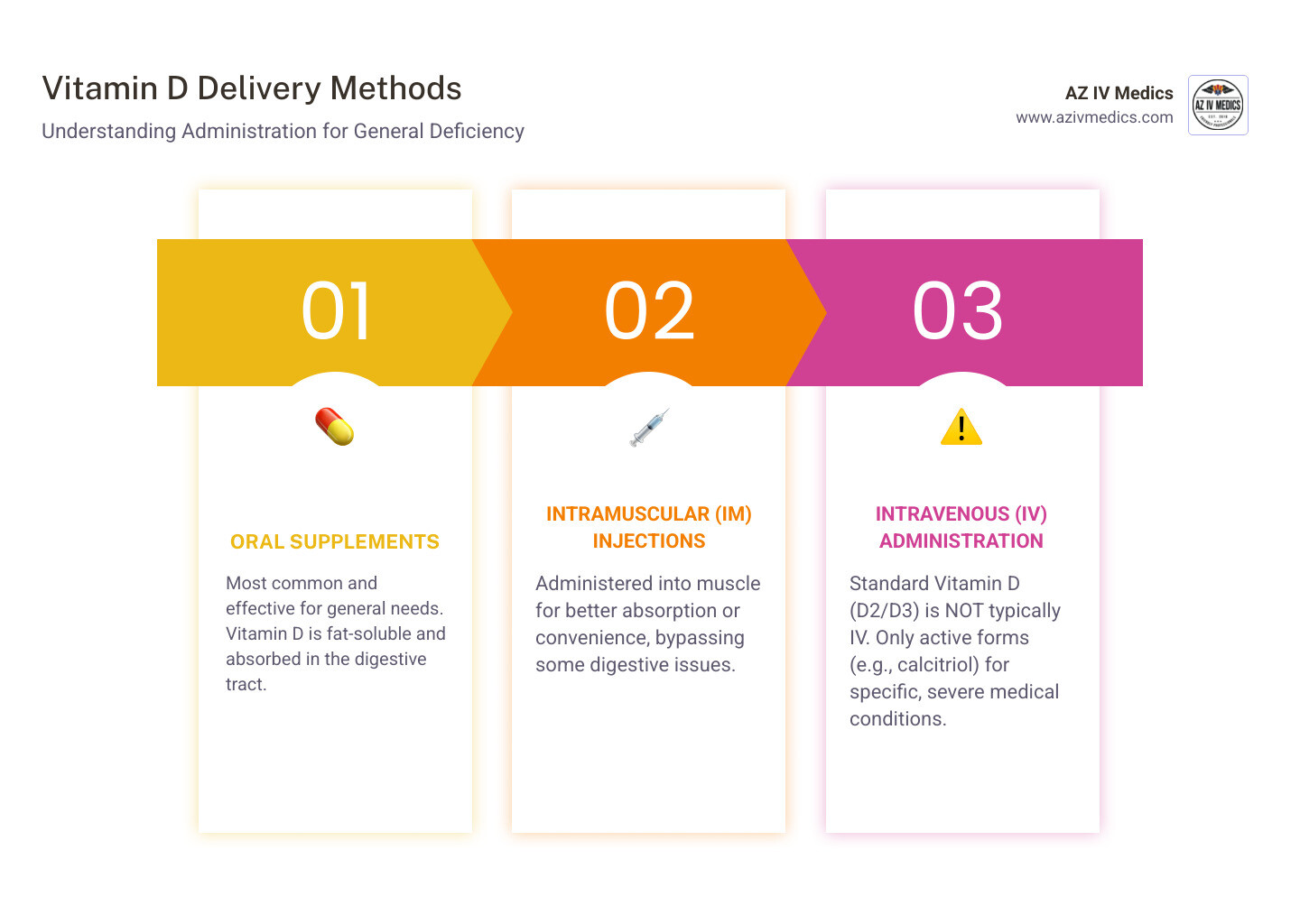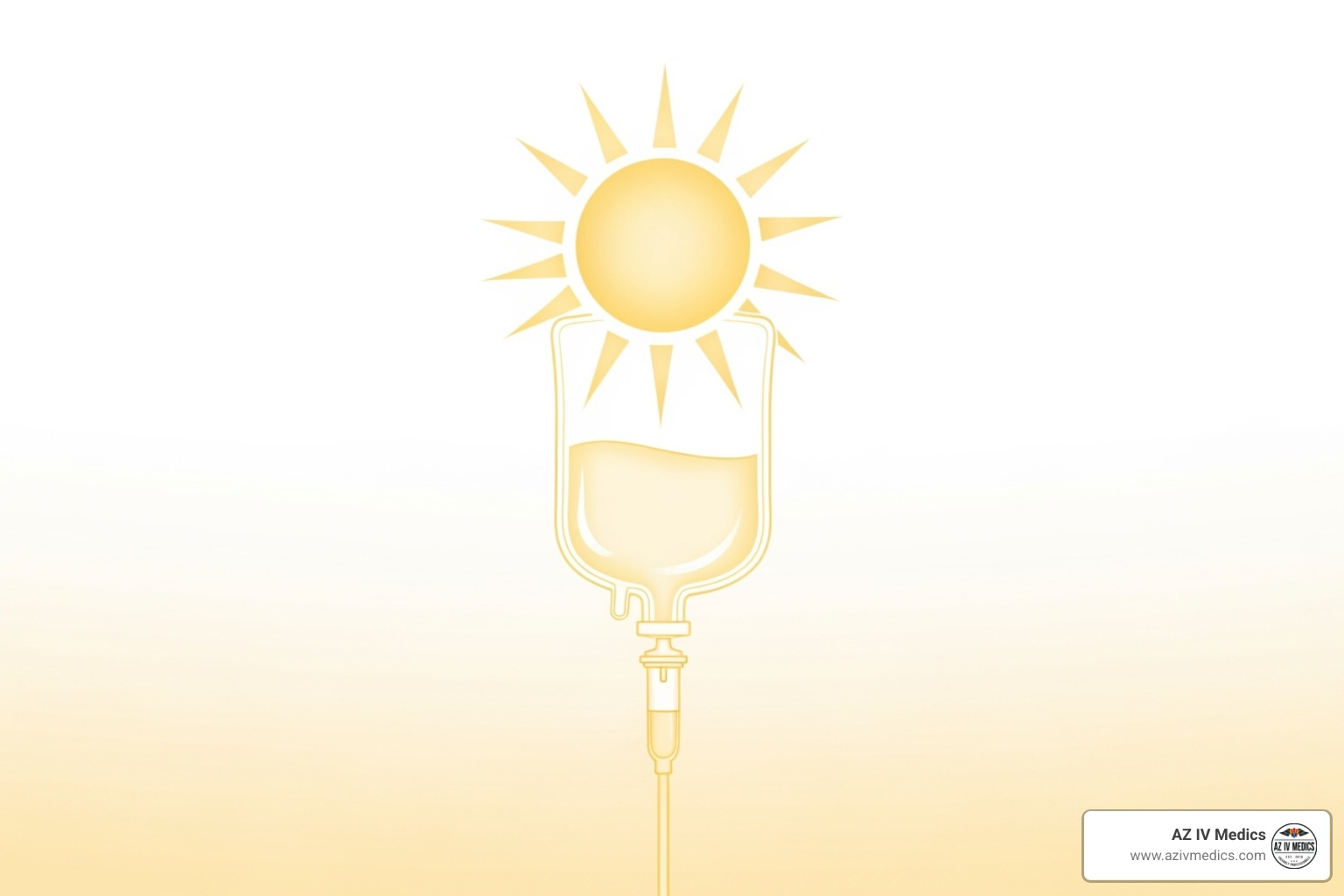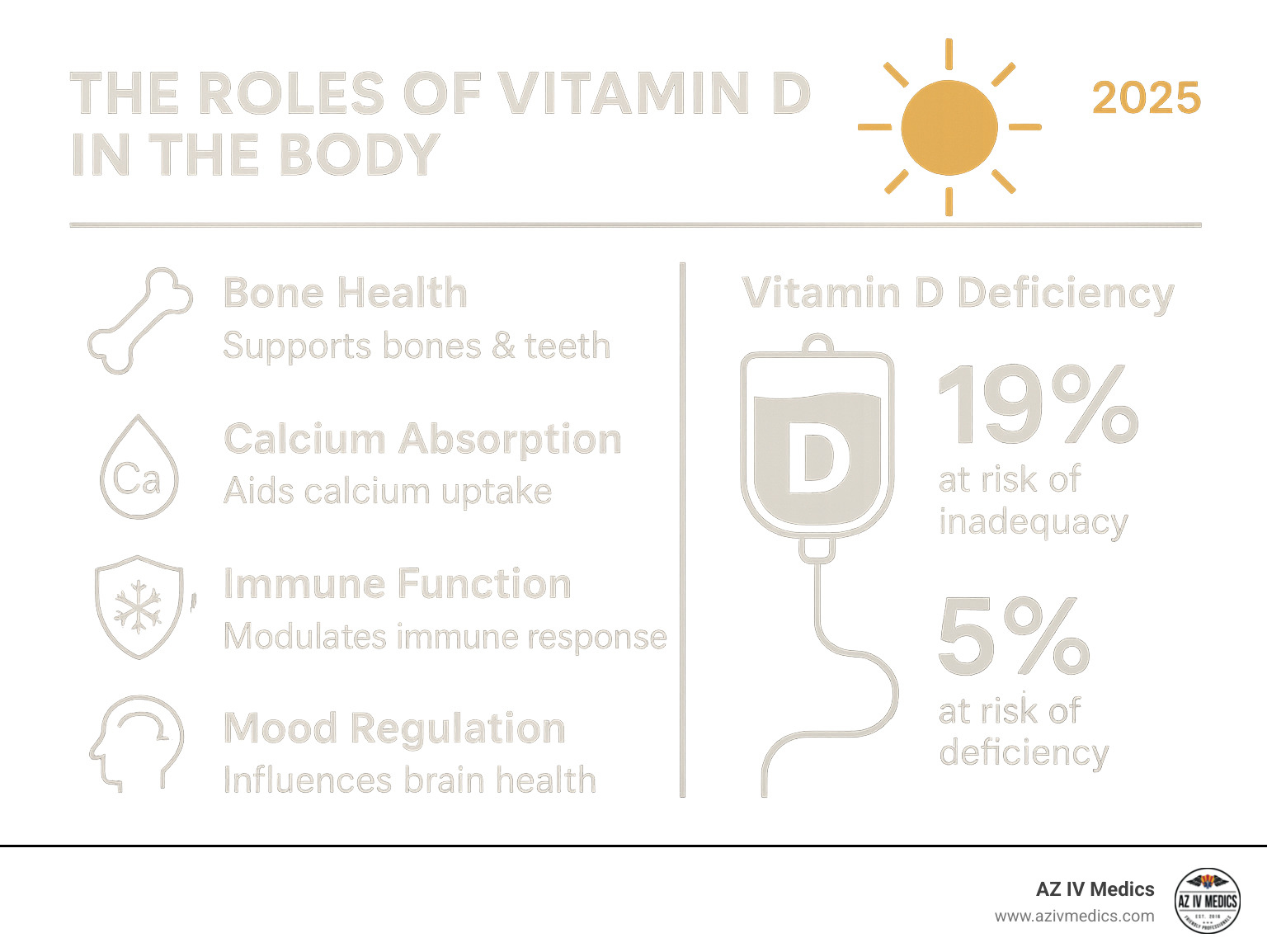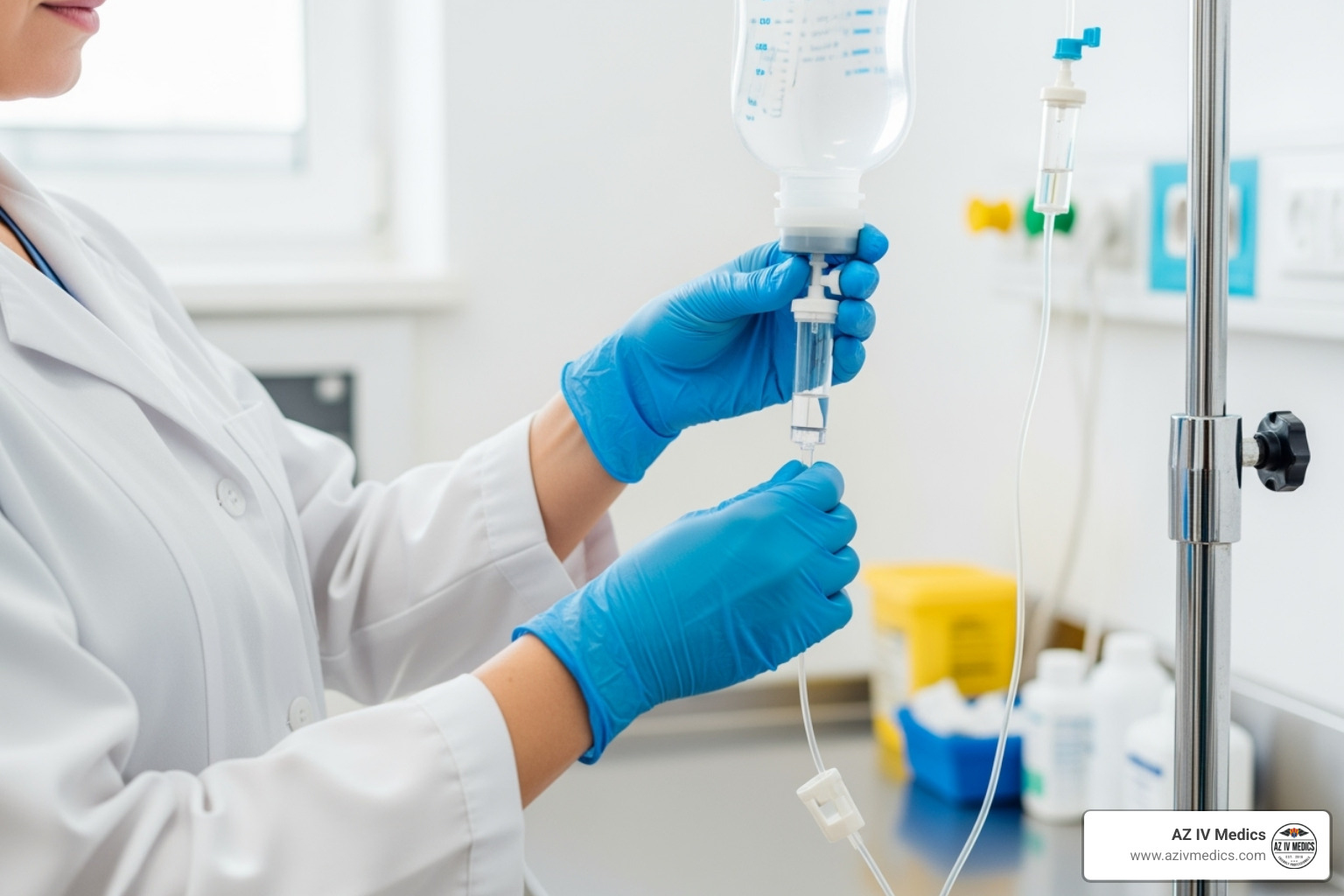Dose It Right: Your Essential Guide to IV Vitamin D Dosing

Medically reviewed by Micaela Strevay, FNP-C, PMHNP-BC
Table of Contents
Why Vitamin D is Crucial and Why Deficiency is So Common

Many people searching for iv vitamin d dose want a quick way to boost their levels, but it's crucial to understand a key distinction.
Here's what you need to know about IV Vitamin D:
-
Standard Vitamin D (D3/D2) is not typically given intravenously (IV).
- Oral supplements are the standard for boosting general levels.
- Injections for better absorption or convenience are almost always intramuscular (IM), not IV.
- Product information for injectable D3, for example, specifies IM injection only.
-
Why isn't regular Vitamin D given IV?
- As a fat-soluble vitamin, it doesn't mix well in water-based IV solutions.
- Oral and IM routes are highly effective for most people.
-
When might "IV Vitamin D" be mentioned?
- The term usually refers to its active form , calcitriol (1,25-dihydroxycholecalciferol).
- Calcitriol is a potent medicine used intravenously for specific conditions like severe kidney disease, where the body can't activate regular vitamin D.
- This is not for general wellness. It requires strict medical supervision.
My experience in mobile IV therapy confirms that while precise nutrient delivery is key, a direct iv vitamin d dose for general supplementation isn't standard practice.
Now, let's explore why vitamin D is so vital.

Vitamin D, the "sunshine vitamin," is an indispensable nutrient vital for overall health, from bone strength to immune function.

Vitamin D is crucial for healthy bones and teeth because it enables calcium absorption from the gut. Without it, calcium can't be used effectively, leading to conditions like osteoporosis.
Beyond bones, Vitamin D is a potent immunomodulator, helping defend against infections and potentially reducing the risk of chronic diseases like cancer, cardiovascular disease, and autoimmune conditions. It also impacts mood and cognitive function, affecting nearly every system in the body.
Despite its importance, deficiency is a global issue. In the U.S., nearly 20% of people are at risk for inadequacy, according to NHANES data. The market for vitamin D supplements, valued at over $1.1 billion in 2020, highlights the scale of this problem.
Why is deficiency so common? Several factors contribute:
- Limited Sun Exposure: Modern lifestyles, geographic location, season, sunblock use, and darker skin tones can all reduce the skin's ability to produce Vitamin D3 from sunlight.
- Dietary Gaps: Few foods are naturally rich in vitamin D, and fortified foods alone are often not enough to meet daily needs.
- Malabsorption Issues: Conditions like Crohn's disease, celiac disease, or bariatric surgery can impair the body's ability to absorb vitamin D.
- Obesity: Vitamin D is fat-soluble and can be trapped in adipose tissue, making it less available to the body. Obese individuals often require higher doses.
- Aging: The skin's ability to synthesize vitamin D from sunlight decreases with age.
- Certain Medications: Some drugs can accelerate the breakdown of vitamin D, leading to lower levels.
These factors create a perfect storm for deficiency, making effective repletion strategies essential.

Why Choose IV Vitamin D? Understanding the Benefits of IV Administration
When discussing iv vitamin d dose , standard D3/D2 is usually taken orally or injected into a muscle. However, the concept of IV delivery is powerful and used for other nutrients and, in specific medical cases, for the active form of vitamin D, calcitriol.
IV therapy acts as an express lane for nutrients, delivering them directly into the bloodstream and bypassing the digestive system for several key benefits:
- Direct Delivery to Your Bloodstream: Nutrients go right where they're needed, without digestive slowdowns.
- 100% Bioavailability: Unlike oral supplements where absorption can be incomplete, IV delivery ensures the full dose enters your system, ready for immediate use. This is a major advantage for fat-soluble vitamins like D.
- Rapid Absorption: Nutrients in the bloodstream are available for your body to use almost instantly, leading to faster effects than pills.
When is IV Vitamin D the Best Choice?
For standard vitamin D (D2 or D3), oral supplements are the first choice. However, if absorption is an issue or daily pills are inconvenient, intramuscular (IM) injections are a superior option. IM injections, often offered in various wellness blends, provide a powerful, sustained boost. Studies have shown that IM injections of vitamin D can lead to a more lasting increase in levels compared to oral doses, making them highly effective.
For the active form of vitamin D (calcitriol), IV administration is the go-to choice, but only under strict medical supervision for specific health challenges, not general wellness. These include:
- Malabsorption Syndromes: In severe cases of Crohn's disease , celiac disease , or post- gastric bypass surgery , where nutrient absorption is compromised, IV calcitriol might be considered.
- Severe Kidney Disease: Kidneys activate vitamin D. In end-stage renal disease, IV calcitriol is used to manage calcium and phosphorus levels.
- Need for Rapid Correction: In urgent medical situations, IV calcitriol provides fast, precise control over calcium and phosphorus levels.
These are specialized medical uses determined by a doctor after a thorough evaluation.
Bioavailability and Efficacy: Why IV Stands Out
Bioavailability—how much of a substance enters your bloodstream—is key when comparing administration methods.
- Oral Administration: Convenient, but absorption of this fat-soluble vitamin is affected by gut health, diet, and metabolism. Daily compliance can also be a challenge.
- Intramuscular (IM) Administration: This method bypasses the digestive system. The vitamin is absorbed from the muscle into the bloodstream, offering excellent bioavailability and more stable, sustained levels than oral doses. It's a great option for those with absorption issues or who prefer not to take daily pills.
- Intravenous (IV) Administration (Calcitriol): For the active form, calcitriol, IV provides 100% immediate bioavailability . The entire dose is instantly available, allowing for rapid, predictable effects crucial in serious medical situations. This means a faster increase in serum levels for specific medical needs.
While oral and IM routes are effective for general D2/D3 repletion, the IV route for calcitriol offers unparalleled speed and directness for specific, medically necessary uses.
Determining the Correct IV Vitamin D Dose
Determining the correct iv vitamin d dose requires understanding that it almost always refers to calcitriol, the active form of vitamin D. This is used in specialized medical situations, such as for patients with severe kidney disease, not for general wellness.
The precise IV calcitriol dose is a highly individualized process. The goal is to safely manage calcium and phosphorus levels, not just to boost general vitamin D stores.

This treatment always requires medical supervision by licensed professionals. They perform regular blood tests to monitor key levels, including:
- Serum Calcium: Checked frequently to prevent dangerously high levels (hypercalcemia).
- Serum Phosphorus: Monitored to ensure a proper balance with calcium.
- Parathyroid Hormone (PTH): Assessed to gauge treatment effectiveness for related disorders.
- 1,25-dihydroxyvitamin D (Calcitriol): Measured to ensure correct dosing without causing toxicity.
Factors That Influence Your Required IV Vitamin D Dose
Personalized care is essential for any high-dose vitamin D treatment. Your specific dose depends on several factors:
- Baseline Levels: For calcitriol, this means your current calcium and phosphorus status. For standard D2/D3, it's your starting 25OH-D level (e.g., severe deficiency is often <10 ng/mL).
- Target Serum Level: The goal for calcitriol is normalizing calcium/phosphorus. For general vitamin D, the target is typically 30-60 ng/mL for optimal health.
- Age: Dosing requirements vary for infants, children, adults, and seniors.
- Obesity: Because vitamin D is stored in fat tissue, individuals with obesity often need higher doses of standard D2/D3 to achieve healthy blood levels.
- Underlying Medical Conditions: Malabsorption syndromes, liver disease, or kidney disease significantly impact how your body processes vitamin D.
- Individual Response: Genetic and other personal factors can alter how you respond to treatment, necessitating careful monitoring and adjustments.
Typical Dosage Ranges for an IV Vitamin D Dose
There is no "typical" general wellness iv vitamin d dose for standard D2 or D3, as they aren't administered this way. IV calcitriol dosing is highly specialized and determined by a physician.
For context, here are common ranges for oral or intramuscular (IM) doses of standard vitamin D (D2/D3) for deficiency:
- For Severe Deficiency (<12 ng/mL): A common oral regimen is 50,000 IU of D2 or D3 weekly for 8-12 weeks. A single IM injection of 300,000 IU of D3 is another effective option.
- For Moderate Deficiency or Insufficiency (12-29 ng/mL): Daily oral doses of 1,000-5,000 IU are typical.
- For Maintenance: Once levels are optimal, a daily dose of 1,000-2,000 IU or a monthly dose of 50,000 IU is common.
IV calcitriol dosing is completely different. A hemodialysis patient might receive 0.5 to 1.0 mcg (micrograms, not IU) three times a week, with the dose adjusted based on lab results. This highlights that calcitriol is a potent, specialized medication.
For general vitamin D repletion, oral or IM methods are the safe and effective standards. Professional consultation is the most important step, as outlined in resources like the Clinical practice guidelines for Vitamin D.
Safety First: Potential Side Effects and Precautions of IV Vitamin D
Safety is paramount. While Vitamin D is essential, too much can cause problems, especially with potent forms like IV calcitriol where the iv vitamin d dose must be carefully controlled.
The primary risk of excess vitamin D is toxicity, which leads to hypercalcemia (too much calcium in your blood).
Symptoms of hypercalcemia can include:
- Digestive issues: Nausea, vomiting, constipation, and loss of appetite.
- Kidney problems: Increased thirst and urination, and in serious cases, kidney damage or stones.
- General symptoms: Weakness, fatigue, confusion, and bone pain.
- Heart issues: In rare cases, it can affect heart rhythm.
Vitamin D toxicity is rare from standard oral or IM D2/D3 unless extremely high doses are taken. However, the risk of hypercalcemia is higher with IV calcitriol due to its potency, which is why close medical monitoring is mandatory.
Who Should Be Cautious with a High IV Vitamin D Dose?
Some individuals require extra caution with high-dose vitamin D (oral, IM, or IV calcitriol). For these groups, medical supervision is essential.
- High Calcium Levels: Anyone with pre-existing hypercalcemia should avoid vitamin D supplements unless directed and monitored by a specialist.
- Kidney Problems: While IV calcitriol is used for severe kidney disease, the dose must be precise to avoid worsening kidney issues. Those with a history of kidney stones also need careful monitoring.
- Certain Diseases: Conditions like sarcoidosis, tuberculosis, or some lymphomas can increase sensitivity to vitamin D, raising the risk of toxicity.
- Williams Syndrome: This rare genetic condition causes extreme sensitivity to D and calcium.
- Arteriosclerosis: High vitamin D and calcium may contribute to calcium buildup in arteries.
A thorough review of your medical history is vital before starting any high-dose vitamin D therapy.
Minimizing Risks: The Professional's Role
This is where the expertise of professional medical teams is critical. While mobile IV services may focus on hydration and other vitamin blends (and may not provide general IV D2/D3), their safety protocols should be universal for all IV treatments.

Here's how medical professionals minimize risks:
- Licensed Medical Professionals: Only qualified providers, like registered nurses or paramedics, administer IV infusions to ensure proper technique and manage any reactions.
- Sterile Equipment: Using sterile, single-use equipment is non-negotiable to prevent infection.
- Proper Administration: Medications are mixed correctly and infused at the proper rate.
- Monitoring Vitals: Vital signs are monitored during the infusion to catch any immediate reactions.
- Follow-up Testing: For any high-dose vitamin D plan, follow-up blood tests are crucial to ensure levels are safe and effective.
For any provider, your safety and comfort should be the top priorities. They can bring professional care to you, often without travel fees or waiting rooms. While they may not offer a general iv vitamin d dose , they are experts in delivering other vital nutrients safely.
Frequently Asked Questions about IV Vitamin D
Let's answer common questions about iv vitamin d dose , remembering the difference between standard vitamin D (D2/D3) and its active form, calcitriol.
How quickly will I feel the effects of IV Vitamin D?
This depends on the type of vitamin D administered.
For IV calcitriol , used in specific medical cases, the effects on calcium and phosphorus levels are very rapid—often within hours—because it's delivered directly to the bloodstream in its active form. This is about correcting internal imbalances, not an immediate energy boost.
For general deficiency treated with oral or IM standard D2/D3, blood levels will rise relatively quickly. However, noticeable improvements in symptoms like fatigue, bone pain, or mood may take several weeks or months as your body rebuilds its stores. Some people report feeling energy and mood improvements faster , but this varies based on the initial severity of the deficiency.
For other nutrients, like those in our popular hydration IVs, many clients report feeling more energized and hydrated almost immediately after their drip.
How often do I need an IV Vitamin D treatment?
Your vitamin D repletion plan is highly individualized. There is no single answer.
For IV calcitriol , the dosing schedule is precisely custom by a doctor based on your medical condition (e.g., dialysis) and your body's response, often requiring infusions several times a week.
For general deficiency treated with standard D2 or D3, the high-impact alternative to oral pills is an intramuscular (IM) injection. The plan often involves:
- Initial Loading Phase: To correct a significant deficiency, you might receive a weekly injection for 8-12 weeks or a single, larger injection to quickly boost your levels.
- Maintenance Phase: Once your levels are optimal, you'll switch to less frequent maintenance doses, perhaps monthly or every few months.
The frequency for any vitamin D plan, including a specialized iv vitamin d dose of calcitriol, is always guided by follow-up blood tests to ensure your levels are in the optimal range.
What makes IV Vitamin D unique?
The uniqueness depends on which form is being discussed.
IV calcitriol is unique because it's the biologically active form of vitamin D. Delivering it intravenously bypasses the body's natural conversion steps in the liver and kidneys. This makes it incredibly potent, 100% immediately bioavailable , and fast-acting. It's designed for severe medical situations where the body cannot activate vitamin D on its own or when rapid control of minerals is needed.
For general deficiency, where a standard iv vitamin d dose isn't used, the uniqueness comes from the benefits of intramuscular (IM) injections over oral supplements:
- Sustained Results: IM injections often lead to a more prolonged increase in vitamin D levels compared to daily pills.
- Bypasses Digestive Issues: IM injections are ideal for those with malabsorption conditions like Crohn's or celiac disease, as they bypass the gut entirely.
- Convenience and Compliance: A single injection can replace weeks or months of daily pills, making it easier to stick with your treatment plan.
Choosing the right path depends on your health goals and medical history, and should always be a decision made with your healthcare provider.
Conclusion: Take the Next Step Towards Optimal Vitamin D Levels
We've covered the incredible importance of Vitamin D for bones, immunity, and more, and why deficiency is so common in modern life.
We've also clarified that a general iv vitamin d dose of standard D2/D3 isn't common medical practice. Oral supplements are the typical start, with highly effective intramuscular (IM) injections being a fantastic alternative for those needing a bigger boost or facing absorption challenges. The active form, calcitriol, is given intravenously, but only for specific, serious medical conditions under strict supervision due to its potency.
The key takeaway is that your journey to optimal vitamin D levels must be personalized and professionally guided. Getting the right dose and method is crucial for both safety and effectiveness.
Mobile IV therapy services are dedicated to bringing professional, safe, and effective wellness solutions directly to you. While they specialize in delivering other essential nutrients and hydration, they champion a comprehensive approach to health. This includes helping you understand powerful nutrients like Vitamin D so you can make informed choices.
Ready to explore how convenient, professional mobile IV therapy can support your health goals? Teams of licensed medical professionals are available to provide high-quality care, right in the comfort of your home, office, or hotel.






